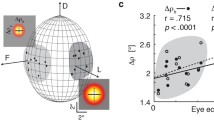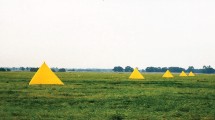Summary
-
1.
Honey bees (Apis mellifera, worker) were trained to discriminate between two random gratings oriented perpendicularly to each other. This task was quickly learned with vertical, horizontal, and oblique gratings. After being trained on perpendicularly-oriented random gratings, bees could discriminate between other perpendicularly-oriented patterns (black bars, white bars, thin lines, edges, spatial sinusoids, broken bars) as well.
-
2.
Several tests indicate that the stimuli were not discriminated on the basis of a literal image (eidetic template), but, rather, on the basis of orientation as a single parameter. An attempt to train bees to discriminate between two different random gratings oriented in the same direction was not successful, also indicating that the bees were not able to form a template of random gratings.
-
3.
Preliminary experiments with oriented ‘Kanizsa rectangles’ (analogue of Kanizsa triangle) suggest that edge detection in the bee may involve mechanisms similar to those that lead to the percept of illusory contours in humans.
Similar content being viewed by others
References
Anderson A (1972) The ability of honey bees to generalize visual stimuli. In: Wehner R (ed) Information processing in the visual systems of arthropods. Springer, Berlin Heidelberg New York, 207–212
Cartwright BA, Collett TS (1983) Landmark learning in bees. J Comp Physiol 151:521–543
Collett TS, Cartwright BA (1983) Eidetic images in insects: their role in navigation. Trends Neurosci 6:101–105
Cruse H (1974) An application of the cross-correlation coefficient to pattern recognition of honey bees. Kybernetik 15:73–84
Eheim WP, Wehner R (1972) Die Sehfelder der zentralen Ommatidien in den Appositionsaugen von Apis mellifica und Cataglyphis bicolor (Apidae, Formicidae; Hymenoptera). Kybernetik 10:168–179
Gould JL (1985) How bees remember flower shapes. Science 227:1492–1494
Gould JL (1986) Pattern learning by honey bees. Anim Behav 34:990–997
Hateren JH van (1990) Directional tuning curves, elementary movement detectors, and the estimation of the direction of visual movement. Vision Res 30:603–614
Kanizsa G (1955) Margini quasi-percettivi in campi con stimolazione omogenea. Rivista di Psicologia 49:7–30. English translation in Petry and Meyer (1987), pp 40–49
Labhart T (1980) Specialized photoreceptors at the dorsal rim in the honeybee's compound eye: polarizational and angular sensitivity. J Comp Physiol 141:19–30
Land MF (1989) Variations in the structure and design of compound eyes. In: Stavenga DG, Hardie RC (eds) Facets of vision. Springer, Berlin Heidelberg New York, pp 90–111
Laughlin SB, Horridge GA (1971) Angular sensitivity of the retinula cells of dark-adapted worker bee. Z Vergl Physiol 74:329–335
Petry S, Meyer GE (1987) The perception of illusory contours. Springer, New York Berlin Heidelberg
Ronacher B (1979) Äquivalenz zwischen Größen- und Helligkeits- unterschieden im Rahmen der visuellen Wahrnehmung der Honigbiene. Biol Cybern 32:63–75
Schefler WC (1979) Statistics for the biological sciences. Addison-Wesley, Reading, Mass, p 48, 62
Srinivasan MV, Lehrer M (1988) Spatial acuity of honeybee vision and its spectral properties. J Comp Physiol A 162:159–172
Wehner R (1971) The generalization of directional visual stimuli in the honey bee, Apis mellifera. J Insect Physiol 17:1579–1591
Wehner R (1972) Dorsoventral asymmetry in the visual field of the bee, Apis mellifica. J Comp Physiol 77:256–277
Wehner R (1981) Spatial vision in arthropods. In: Autrum H (ed) Vision in Invertebrates (Handbook of sensory physiology, vol VII/6C). Springer, Berlin Heidelberg New York, pp 287–616
Wehner R, Flatt I (1977) Visual fixation in freely flying bees. Z Naturforsch 32c: 469–471
Wolf E (1933) Das Verhalten der Bienen gegenüber flimmernden Feldern und bewegten Objekten. Z Vergl Physiol 20:151–161
Zerrahn G (1933) Formdressur und Formunterscheidung bei der Honigbiene. Z Vergl Physiol 20:117–150
Author information
Authors and Affiliations
Rights and permissions
About this article
Cite this article
van Hateren, J.H., Srinivasan, M.V. & Wait, P.B. Pattern recognition in bees: orientation discrimination. J Comp Physiol A 167, 649–654 (1990). https://doi.org/10.1007/BF00192658
Accepted:
Issue Date:
DOI: https://doi.org/10.1007/BF00192658




